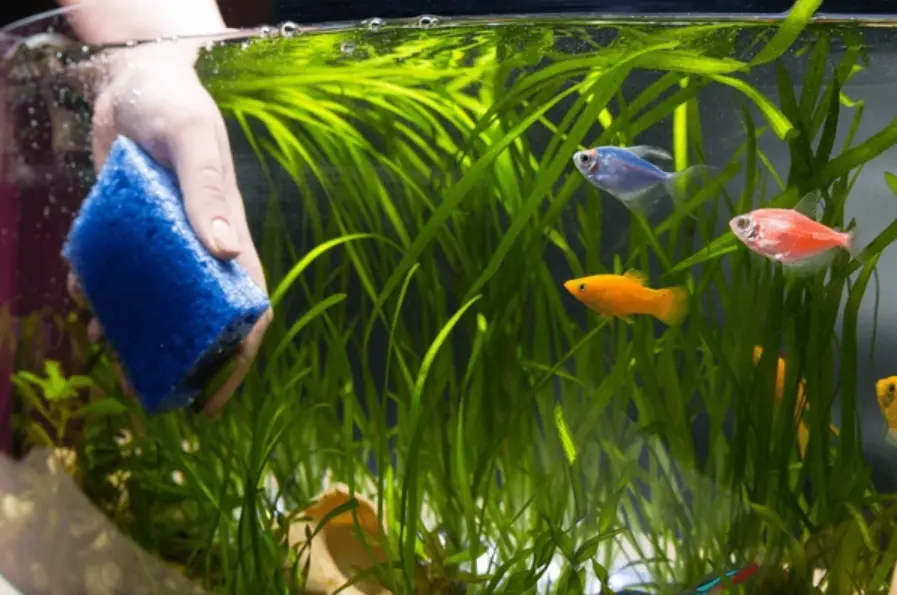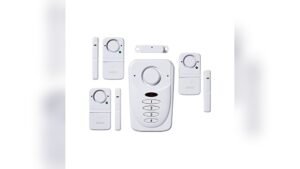Imagine coming home after a long day to the soothing sight of your vibrant aquarium, its waters clear and your fish swimming happily. Yet, maintaining this peaceful oasis requires a bit of effort.
If you’ve ever wondered how to clean your aquarium effectively without disrupting your aquatic friends, you’re in the right place. Your fish depend on a clean environment to stay healthy and lively. But the task may seem daunting or even mysterious at first.
Don’t worry; you’ve got this. With the right approach, you can turn what feels like a chore into a simple and satisfying routine. Ready to dive in? Let’s explore the best steps to keep your aquarium sparkling and your fish thriving.

Credit: www.fabglassandmirror.com
Essential Tools
Cleaning an aquarium requires specific tools. These tools make maintenance simple. They ensure the tank stays healthy. Using the right tools also saves time. Let’s explore the essential tools for aquarium cleaning.
Gravel Vacuum
The gravel vacuum is vital for cleaning the aquarium floor. It removes debris from the gravel. Fish waste and uneaten food can gather here. A gravel vacuum helps keep the water clean. It also prevents harmful bacteria buildup.
Algae Scraper
An algae scraper keeps the glass clear. Algae can cloud the view inside the tank. This tool wipes away algae growth. The scraper is easy to use. It helps maintain a clean and beautiful aquarium appearance.
Water Conditioner
Water conditioner is crucial for healthy fish. Tap water often contains chlorine. This chemical can harm fish. A conditioner neutralizes these harmful substances. It ensures safe water for the aquatic life. Regular use is recommended.
Routine Maintenance
Routine maintenance is crucial for a healthy aquarium. It ensures a clean and safe environment for your fish. Regular tasks prevent water quality issues. This keeps your aquatic life happy and thriving.
Daily Tasks
Observe your fish daily. Check for any unusual behavior or appearance. Feed them the right amount of food. Remove any uneaten food after feeding. This prevents water contamination. Check water temperature daily. Ensure it stays within the optimal range. Inspect the equipment for proper functioning.
Weekly Duties
Change 10-15% of the water weekly. This removes toxins and waste. Clean the glass with an algae scraper. It improves visibility. Rinse the filter media in tank water. This keeps beneficial bacteria intact. Vacuum the substrate lightly. Remove debris without disturbing plants.
Monthly Check-ups
Test water parameters monthly. Ensure levels are safe for fish. Inspect and clean the filter thoroughly. Replace parts if needed. Trim plants to maintain their health. Check all equipment for wear and tear. Replace any faulty components.
Water Quality Testing
Maintaining water quality is crucial for a healthy aquarium. Regular testing prevents harmful conditions. It keeps fish and plants thriving. Testing identifies issues early. This saves time and resources. Let’s explore key aspects of water quality testing.
Ph Levels
pH measures water acidity or alkalinity. Fish need stable pH levels. Most aquariums do well between 6.5 and 7.5 pH. Test water weekly. Adjust pH using natural solutions. This ensures a safe environment.
Ammonia And Nitrite
Ammonia and nitrite are harmful. They result from fish waste and uneaten food. High levels stress or kill fish. Test weekly to keep levels safe. Use water conditioners if needed. They neutralize harmful substances.
Nitrate Levels
Nitrates are less toxic. But high levels can cause algae growth. This affects water clarity and oxygen levels. Test every two weeks. Perform partial water changes to manage nitrates. This keeps the aquarium clean and healthy.
Filter Care
Maintaining a clean aquarium involves proper filter care. Regularly rinse and replace filter media to remove debris and impurities. Ensure the filter functions efficiently to keep water clear and healthy for aquatic life.
Cleaning your aquarium filter regularly is essential. It ensures a healthy environment for your fish. A well-maintained filter can extend the life of your aquarium inhabitants. This section will guide you through choosing, cleaning, and replacing your filter.Choosing The Right Filter
Selecting the right filter depends on your aquarium size. Consider the type of fish and water capacity. Many types of filters exist. Hang-on-back filters are popular for small tanks. Canister filters suit larger aquariums. Under-gravel filters are another option. Match the filter to your tank’s needs. Efficient filtration keeps water clear. It also removes harmful substances.Cleaning Techniques
Cleaning your filter is crucial. It prevents debris build-up. Unplug the filter before cleaning. Remove the media and rinse it in old tank water. This preserves beneficial bacteria. Avoid using tap water; it can harm bacteria. Clean the filter housing with a brush. Check the impeller for debris. Keep all parts free from blockages. Reassemble the filter carefully.Replacement Schedule
Replacing filter media is necessary. It ensures optimal performance. Follow the manufacturer’s guidelines. Typically, replace media every four weeks. Sponge filters may last longer. Carbon filters need more frequent changes. Keep a schedule to track replacements. Old media can lose effectiveness. Fresh media maintains water quality. Regular checks prevent sudden problems.Algae Control
Keeping an aquarium can be a rewarding hobby. Yet, algae growth often frustrates enthusiasts. Algae can cloud water and harm fish. Understanding how to manage it is key.
Identifying Algae Types
Algae come in various forms. Green algae are common. They appear as green spots on glass. Brown algae, or diatoms, coat surfaces in a brown film. Blue-green algae are toxic. They create a slimy layer.
Preventive Measures
Maintain water quality to prevent algae. Check filter and change water regularly. Control light exposure. Too much light encourages algae growth. Balance nutrients by avoiding overfeeding.
Safe Removal Methods
Manual removal is safe. Scrub glass with a soft brush. Remove algae-covered decorations and clean them. Use algae-eating fish like snails or plecos. They naturally consume algae.

Credit: www.aquariumcoop.com
Fish And Plant Health
Maintaining fish and plant health is crucial for a thriving aquarium. A clean environment ensures vibrant colors and active behaviors in fish. Healthy plants not only enhance the beauty but also provide essential oxygen. Regular cleaning practices help prevent diseases and stress in aquatic life.
Signs Of Stress
Stressed fish exhibit erratic swimming and loss of appetite. Faded colors and hiding are common signs. Watch for unusual breathing patterns. Healthy fish should breathe calmly and evenly. Plants may wilt or show discoloration when stressed. Regular checks help spot these signs early.
Balancing Ecosystem
A balanced ecosystem prevents stress in fish and plants. Ensure water pH levels remain stable. Correct temperature is vital for fish health. Overcrowding can lead to stress and disease. Maintain proper lighting for plant growth. Regular monitoring keeps the ecosystem balanced.
Quarantine Procedures
Quarantine new fish to prevent disease spread. Separate tank for new arrivals is essential. Observe new fish for signs of illness. Healthy fish should adapt quickly. Quarantine duration should be at least two weeks. This practice protects your main tank’s inhabitants.
Troubleshooting Common Issues
Maintaining a healthy aquarium can be challenging. Even with regular care, problems arise. Understanding these common issues helps keep your fish happy. Let’s explore some typical challenges and solutions.
Cloudy Water
Cloudy water is often a sign of imbalance. It may result from overfeeding or insufficient filtration. Check your filter to ensure it’s functioning properly. Reduce feedings to clear the water. Adding beneficial bacteria helps too. If the problem persists, consider a partial water change.
Unpleasant Odors
Unpleasant odors indicate waste buildup. Regular cleaning reduces smells effectively. Ensure you remove uneaten food and debris. Changing water every week helps manage odor. An efficient filter also keeps the water fresh. Monitor the ammonia levels for safety.
Fish Behavior Changes
Fish behavior changes can signal stress. Check water temperature and quality. Ensure the tank has enough space. Look for signs of disease or parasites. Sudden behavior shifts require immediate attention. Adjust the environment to restore harmony.

Credit: m.youtube.com
Frequently Asked Questions
How Often Should I Clean My Aquarium?
Cleaning your aquarium depends on its size and type. Generally, it’s recommended to clean it every two weeks. Regular maintenance ensures a healthy environment for your fish and plants. Keeping up with cleaning prevents algae buildup and maintains water quality.
What Tools Do I Need To Clean My Aquarium?
You’ll need a gravel vacuum, algae scraper, and fish-safe cleaner. A bucket and sponge are useful for water changes. These tools help efficiently remove debris and maintain a clean habitat. Regular use ensures your aquarium stays visually appealing and healthy for its inhabitants.
How Do I Remove Algae From My Aquarium?
Use an algae scraper or pad to gently remove algae from glass surfaces. Regular cleaning prevents excessive buildup. Consider adding algae-eating fish or snails to naturally control algae. Maintaining proper lighting and water conditions also reduces algae growth effectively.
Can I Clean My Aquarium With Tap Water?
Tap water can be used, but it requires treatment with a water conditioner. This neutralizes harmful chemicals. Ensure the water is at the right temperature before adding it. Regularly monitor water quality to ensure the health of your aquatic life.
Conclusion
Keeping your aquarium clean is essential for healthy fish. Regular maintenance prevents algae build-up and keeps water fresh. Check filters weekly to ensure proper function. A clean tank reduces fish stress and boosts their lifespan. Always use safe cleaning materials to avoid harming aquatic life.
Follow a cleaning schedule for best results. Happy fish mean a happy aquarium. Enjoy watching your vibrant, healthy underwater world. Careful attention brings rewards. Cleaner tanks, happier fish. Keep your aquarium sparkling and thriving with simple, regular care. Your fish deserve the best environment.







